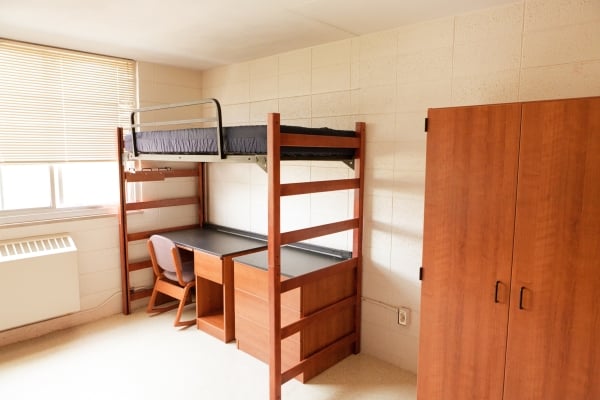
Student Preferences in On-Campus Housing
Recent survey data focused on student housing officers shows students want more privacy and mental health supports.
YinYang/iStock/Getty Images Plus
What do students look for in on-campus housing? According to university staff, students are most satisfied with their space when it’s well furnished and clean.
A new report from StarRez, a student housing management platform, identified room conditions and a sense of community as top priorities for on-campus housing residents. The survey also found that a majority of institutions see social events and mental health support as key to the student experience in residence halls.
In addition, the research reveals that today’s students prefer privacy in their living space but are still interested in creating connections and engaging with peers who share their residence hall. They are also open to opportunities to build living-learning communities.
Methodology
StarRez’s survey was fielded between Feb. 10 and April 14, 2025. It yielded 459 responses from 418 institutions across the globe, including 360 institutions based in the Americas.
Setting the stage: An estimated 16 percent of all undergraduates live on campus, including 30 percent of those who attend four-year, public institutions and 43 percent of students at independent colleges, according to an analysis from the American Association of Community Colleges.
Previous research shows that students who live in residential housing on campus are more likely than their peers who live off campus to persist and complete a degree. This trend may be due in part to the proximity to peer support, academic resources and security in basic needs that living on campus affords.
In recent years, many colleges have seen a housing crunch impact their students, resulting in less-than-ideal accommodations and residence halls exceeding capacity. StarRez’s survey found that 64 percent of responding institutions had 90 percent or higher occupancy rates; 15 percent had occupancy rates of 99 percent or higher. Yet nearly 57 percent of students do not have access to on-campus housing, according to respondent data.
But StarRez’s report points to a post-pandemic spike in students interested in living on campus—a trend that has leveled out this year—meaning the exceptionally high demand for on-campus housing may decline.
Affordability also remains a growing concern in the campus housing market. Student housing prices are rising faster than those of single-family housing, growing 8.8 percent in 2023 compared to multifamily rentals, which rose 4.5 percent in cost over the same period.
Survey says: When students say they’re satisfied with their housing, approximately one-third are referring to the room conditions and furnishings, their sense of community, or the residence hall’s amenities, according to institutional respondents.
On the flip side, cost, facility issues and dissatisfaction with food or meal plans were the most commonly reported criticisms of on-campus living. Inside Higher Ed’s Student Voice survey from 2023 found that 48 percent of students believe their dining hall options need improvement and 37 percent said dining facilities need improvement.
Across room types, apartment-style housing is the most requested option by students (34 percent), followed by suite-style housing (27 percent) and traditional dorms (21 percent), according to StarRez’s survey. The report also found that a greater share of students want their own space; at a majority of institutions (51 percent), students rank single rooms as their top choice on the housing application.
Not every housing placement turns out to be successful. A majority of colleges said more than 10 percent of their residents requested a room change during the year, with 8 percent saying between 25 and 50 percent of residents asked for a new room.
Among events offered to residents, 90 percent said social events are the most popular and widely attended, followed by recreational activities (56 percent) and wellness programs (39 percent).
When asked which health and well-being activities students most often requested of their housing facility, nearly 60 percent of respondents said mental health support programs, and over half (56 percent) wanted social events and community-building activities. Less popular responses included counseling and peer support networks (46 percent), healthy dining options (38 percent), and financial and academic support services (36 percent).
Living-learning communities continue to grow in popularity, with four out of five colleges offering this type of student housing. Academic-focused communities (23 percent) and honors programs (17 percent) were the most popular LLCs, while career (5 percent) and leadership-focused (6 percent) groups were the least popular.
National data shows students with disabilities are enrolling in higher education at higher rates, and StarRez’s report points to an increase in emotional support animals making their way to campus as well. One-third of institutions said between 3 and 10 percent of residents have emotional support animals, with 3 percent of respondents saying more than 10 percent of students have them.
Fewer institutions reported offering gender-inclusive housing in 2025 (69 percent) than in 2024 (73 percent), and there was little difference in the number who said they were considering implementing gender-inclusive housing space.
Growth in international student enrollment is also pushing an increase in housing demand from international students, with 34 percent of respondents indicating a slight increase and 6 percent reporting a significant increase. A majority of respondents house fewer than 10 percent of their international students on campus. The report data does not reflect recent federal actions this spring that may impede international student enrollment in the fall.
So what? Based on the report’s findings, authors recommend housing providers consider:
- Students’ desire for privacy, mental health and belonging, which are core to their experiences on campus.
- More students want apartment-style and single-room housing options, creating opportunities for institutions to adapt spaces to match this need.
- Living and learning communities can provide high-impact experiences for residents, leading to greater satisfaction and retention.
How does your institution promote belonging and well-being in the residence halls? Tell us more.
Source link



